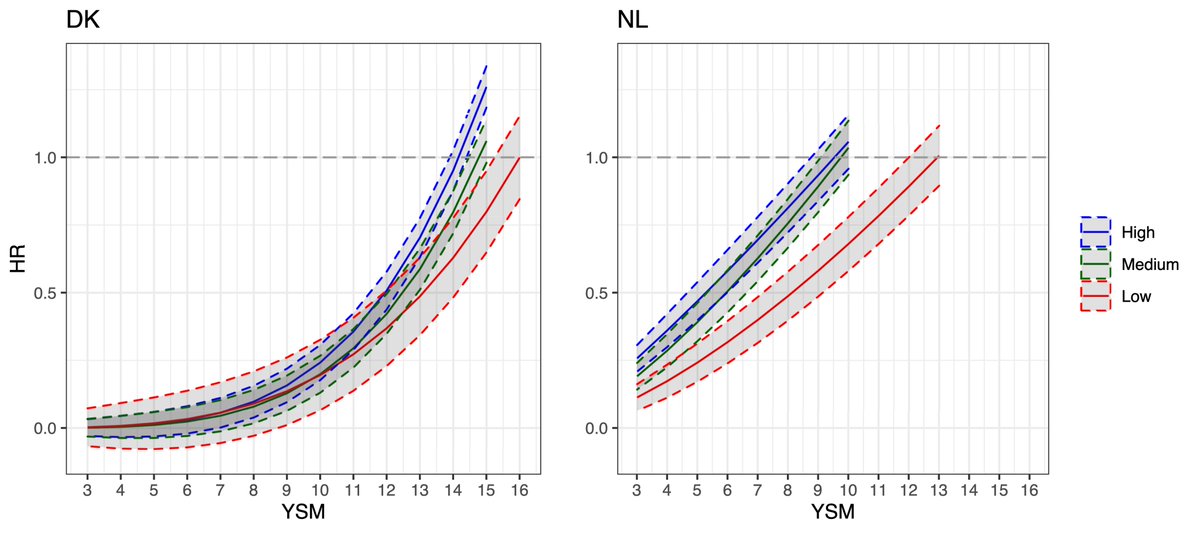
New paper on
Long-term heterogeneity in immigrant naturalisation
with Anna Tegunimataka (@lunduniversity), Floris Peters (@macimide) and Pieter Bevelander (@MalmoMigration)
is now available in @ESR_news! 🌞
@MiLifeStatus @ERC_Research
a thread /1
Long-term heterogeneity in immigrant naturalisation
with Anna Tegunimataka (@lunduniversity), Floris Peters (@macimide) and Pieter Bevelander (@MalmoMigration)
is now available in @ESR_news! 🌞
@MiLifeStatus @ERC_Research
a thread /1
https://twitter.com/ESR_news/status/1356898371403931650?s=20
/2
Paper draws on data from admin registers
on 642k migrants from 8 cohorts
in 🇩🇰, 🇳🇱 and 🇸🇪
tracked up to 21 ysm
N=4.3M obs
We observe large differences in cumulative naturalisation rates:
🇸🇪 80%
🇳🇱 67%
🇩🇰 37%
Differences increase after contrasting policy changes.
Paper draws on data from admin registers
on 642k migrants from 8 cohorts
in 🇩🇰, 🇳🇱 and 🇸🇪
tracked up to 21 ysm
N=4.3M obs
We observe large differences in cumulative naturalisation rates:
🇸🇪 80%
🇳🇱 67%
🇩🇰 37%
Differences increase after contrasting policy changes.

/3
Language requirements and integration tests were introduced in both Denmark (B1/B2) and the Netherlands (A2), but not in Sweden.
Dual citizenship was restricted in the Netherlands but liberalised in Sweden.
Language requirements and integration tests were introduced in both Denmark (B1/B2) and the Netherlands (A2), but not in Sweden.
Dual citizenship was restricted in the Netherlands but liberalised in Sweden.

/4
We employ stratified Cox proportional hazard models to model duration until naturalisation.
We find that the introduction of citizenship tests is associated with substantial naturalisation gaps in both 🇩🇰 and 🇳🇱, esp. among migrants with lower educational background.
We employ stratified Cox proportional hazard models to model duration until naturalisation.
We find that the introduction of citizenship tests is associated with substantial naturalisation gaps in both 🇩🇰 and 🇳🇱, esp. among migrants with lower educational background.

/5
Our findings on selection effects of civic 'integration' requirements are in line with previous work by @kkrjensen et al on 🇩🇰
doi.org/10.1080/136918…
Our findings on selection effects of civic 'integration' requirements are in line with previous work by @kkrjensen et al on 🇩🇰
doi.org/10.1080/136918…
/6
Our estimates suggest that the introduction of civic integration requirements is associated with substantial delays in naturalisation.
Even in 🇳🇱 with modest A2 language requirement, esp. among lower educated migrants.
Our estimates suggest that the introduction of civic integration requirements is associated with substantial delays in naturalisation.
Even in 🇳🇱 with modest A2 language requirement, esp. among lower educated migrants.

/7
When looking at #dualcitizenship, liberalisation increases the propensity to naturalise, but relevance is strongly conditioned by migrants’ origin context.
Higher rates if dual citizenship possible, esp. among 🇪🇺 migrants and those from highly developed origin countries.
When looking at #dualcitizenship, liberalisation increases the propensity to naturalise, but relevance is strongly conditioned by migrants’ origin context.
Higher rates if dual citizenship possible, esp. among 🇪🇺 migrants and those from highly developed origin countries.

/8
We find that being able to retain one’s origin citizenship is associated with durably higher naturalisation rates among EU citizens 🇪🇺 and migrants from highly developed countries.
We find that being able to retain one’s origin citizenship is associated with durably higher naturalisation rates among EU citizens 🇪🇺 and migrants from highly developed countries.

/9
These results on delaying (civic integration requirement) and putting off naturalisation (dual citizenship restriction) are in line with earlier work on 🇳🇱 with @LabussiereMarie.
doi.org/10.1080/136918….
These results on delaying (civic integration requirement) and putting off naturalisation (dual citizenship restriction) are in line with earlier work on 🇳🇱 with @LabussiereMarie.
doi.org/10.1080/136918….
@threadreaderapp unroll
• • •
Missing some Tweet in this thread? You can try to
force a refresh





